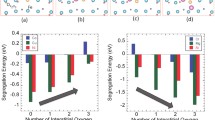Abstract
Atom probe tomography is used to measure interfacial and grain boundary segregation in the thermally grown oxide layers found on thermal barrier coatings formed by isothermal heat treatments at 1,100 °C. Segregation of Zr, Hf, Y, and minor elements at the metal/oxide interfaces, oxide grain boundaries and oxide dislocations are observed, quantified and rationalised. The implications of the findings are discussed.




Similar content being viewed by others
References
D. V. Rigney, et al., PVD thermal barrier coating applications and process development for aircraft engines. J Thermal Spray Technol 6, (2), 167–175 (1997).
R. C. Reed, The superalloys: fundamentals and applications, Cambridge University Press, Cambridge, (2006).
R. A. Miller, Current status of thermal barrier coatings—an overview. Surf Coat Technol 30, (1), 1–11 (1987).
N. P. Padture, M. Gell and E. H. Ordan, Thermal barrier coatings for gas-turbine engine applications. Science 296, 280–284 (2002).
M. Stiger, et al., Thermal barrier coatings for the 21st century. Zeitschrift fur Metallkunde 90, (12), 1069–1078 (1999).
A. Rabiei and A. Evans, Failure mechanisms associated with the thermally grown oxide in plasma-sprayed thermal barrier coatings. Acta Mater 48, (15), 3963–3976 (2000).
M. Gell, et al., Mechanism of spallation in platinum aluminide/electron beam physical vapor-deposited thermal barrier coatings. Metall Mater Trans A 30, (2), 427–435 (1999).
B. Pint, et al., Substrate and bond coat compositions: factors affecting alumina scale adhesion. Mater Sci Eng A 245, (2), 201–211 (1998).
R. T. Wu, et al., The retention of thermal barrier coating systems on single-crystal superalloys: effects of substrate composition. Acta Mater 56, (14), 3622–3629 (2008).
J. L. Smialek, Effect of sulfur removal on Al2O3 scale adhesion. Metall Trans A 22, (3), 739–752 (1991).
A. G. Evans, et al., Mechanisms controlling the durability of thermal barrier coatings. Progress Mater Sci 46, (5), 505–553 (2001).
D. Whittle and J. Stringer, Improvements in high temperature oxidation resistance by additions of reactive elements or oxide dispersions. Philos Trans R Soc London Ser A 295, (1413), 309–329 (1980).
A. H. Heuer, et al., Alumina scale formation: a New Perspective. J Am Ceram Soc 94, S146–S153 (2011).
B. Pint and K. More, Characterization of alumina interfaces in TBC systems. J Mater Sci 44, (7), 1676–1686 (2009).
K. A. Unocic, C. M. Parish and B. A. Pint, Characterization of the alumina scale formed on coated and uncoated doped superalloys. Surf Coat Technol 206, (7), 1522–1528 (2011).
Y. Chen, R. C. Reed and E. A. Marquis, As-coated thermal barrier coating: structure and chemistry. Scr Mater 67, (9), 779–782 (2012).
L. A. Giannuzzi and F. A. Stevie, A review of focused ion beam milling techniques for TEM specimen preparation. Micron 30, (3), 197–204 (1999).
K. Thompson, et al., In situ site-specific specimen preparation for atom probe tomography. Ultramicroscopy 107, (2–3), 131–139 (2007).
K. S. Murphy, K. L. More and M. J. Lance, As-deposited mixed zone in thermally grown oxide beneath a thermal barrier coating. Surf Coat Technol 146–147, 152–161 (2001).
E. A. Marquis, et al., Probing the improbable: imaging C atoms in alumina. Mater Today 13, (10), 34–36 (2010).
O. C. Hellman, et al., Application software for data analysis for three-dimensional atom probe microscopy. Mater Sci Eng A 327, 29–33 (2002).
J. Cho, et al., Role of segregating dopants on the improved creep resistance of aluminum oxide. Acta Mater 47, (5), 4197–4207 (1999).
B. Veal and A. Paulikas, Growth strains and creep in thermally grown alumina: oxide growth mechanisms. J Appl Phys 104, (9), 093525 (2008).
B. A. Pint, Experimental observations in support of the dynamic-segregation theory to explain the reactive-element effect. Oxid Met 45, (1–2), 1–37 (1996).
S. Lartigue-Korinek, et al., HAADF study of the relationship between intergranular defect structure and yttrium segregation in an alumina grain boundary. Acta Mater 59, (9), 3519–3527 (2011).
I. Milas, B. Hinnemann and E. A. Carter, Structure of and ion segregation to an alumina grain boundary: implications for growth and creep. J Mater Res 23, (5), 1494–1508 (2008).
M. Sillassen, et al., Effects of dopant concentration and impurities on the conductivity of magnetron-sputtered nanocrystalline yttria-stabilized zirconia. Solid State Ionics 181, (19), 864–867 (2010).
M. J. Stiger, et al., Development of intermixed zones of alumina/Zirconia in thermal barrier coating systems. Metall Mater Trans A 38A, (4), 848–857 (2007).
M. Chi and H. Gu, Comparison of segregation behaviors for special and general boundaries in polycrystalline Al2O3 with SiO2–TiO2 impurities. Interface Sci 12, (2–3), 335–342 (2004).
D. Bouchet, F. Dupau and S. Lartigue-Korinek, Structure and chemistry of grain boundaries in yttria doped aluminas. Microsc Microanal Microstruct 4, (6), 561–573 (1993).
M. Gülgün, et al., Cation segregation in an oxide ceramic with low solubility: yttrium doped α-alumina. Interface Sci 10, (1), 99–110 (2002).
A. Heuer, N. J. Tighe and R. Cannon, Plastic deformation of fine-grained alumina (Al2O3): II, basal slip and nonaccommodated grain-boundary sliding. J Am Ceram Soc 63, (1–2), 53–58 (1980).
A. Heuer, et al., On the growth of Al2O3 scales. Acta Mater 61, (18), 6670–6683 (2013).
R. T. Wu and R. C. Reed, On the compatibility of single crystal superalloys with a thermal barrier coating system. Acta Mater 56, (3), 313–323 (2008).
Acknowledgments
This work was partly supported by The University of Michigan College of Engineering.
Author information
Authors and Affiliations
Corresponding author
Rights and permissions
About this article
Cite this article
Chen, Y., Reed, R.C. & Marquis, E.A. Interfacial Solute Segregation in the Thermally Grown Oxide of Thermal Barrier Coating Structures. Oxid Met 82, 457–467 (2014). https://doi.org/10.1007/s11085-014-9502-7
Received:
Revised:
Published:
Issue Date:
DOI: https://doi.org/10.1007/s11085-014-9502-7



